Physical Address
304 North Cardinal St.
Dorchester Center, MA 02124
Intervertebral disc displacement is not a “disease,” but is a component of many variations of disorders of the spine.
The displaced disc material and the effects it creates must be carefully assessed and its origin sought by clinical examination and imaging.
Coordination of clinical and imaging findings is a necessary prelude to treatment.
Accurate conceptualization and communication require an understanding of terminology.
Understanding the terminology of displacement of intervertebral discs (IVDs) is critical to conceptualization and communication. Meanings of the most basic terms, such as “disc” and “displacement,” vary with context, speaker, and listener. However, even the most compulsive nomenclature curmudgeon will, at times, use terms in a relaxed fashion with the assumption that the listener understands. In a textbook, however, we cannot make such assumptions; therefore, the language of this discussion will remain true to accepted meaning [ ]. Accurate and clearly understood description of the variety of phenotypes of displaced IVDs takes us far from simplistic “jelly-donut” metaphors.
An IVD is a composite structure whose components vary with genetic make-up, age, and environmental influence [ ] (see Chapter 1 ). Its center, the nucleus pulposus (NP), lies within a space bounded, cephalad and caudad, by cartilage endplates and, peripherally, by a ligament, the annulus (correct alternative spelling is anulus) fibrosus (no correct alternative as “fibrosis” has a different meaning) (see Chapter 10, Chapter 12 ). The normal NP is composed of type II collagen, proteoglycan hyaluronate, with high water content [ ]. The annulus is composed of collagen type I fibrous tissue ( Fig. 8.1 ). Any or all of these components are subject to displacement from their normal location within the IVD space.
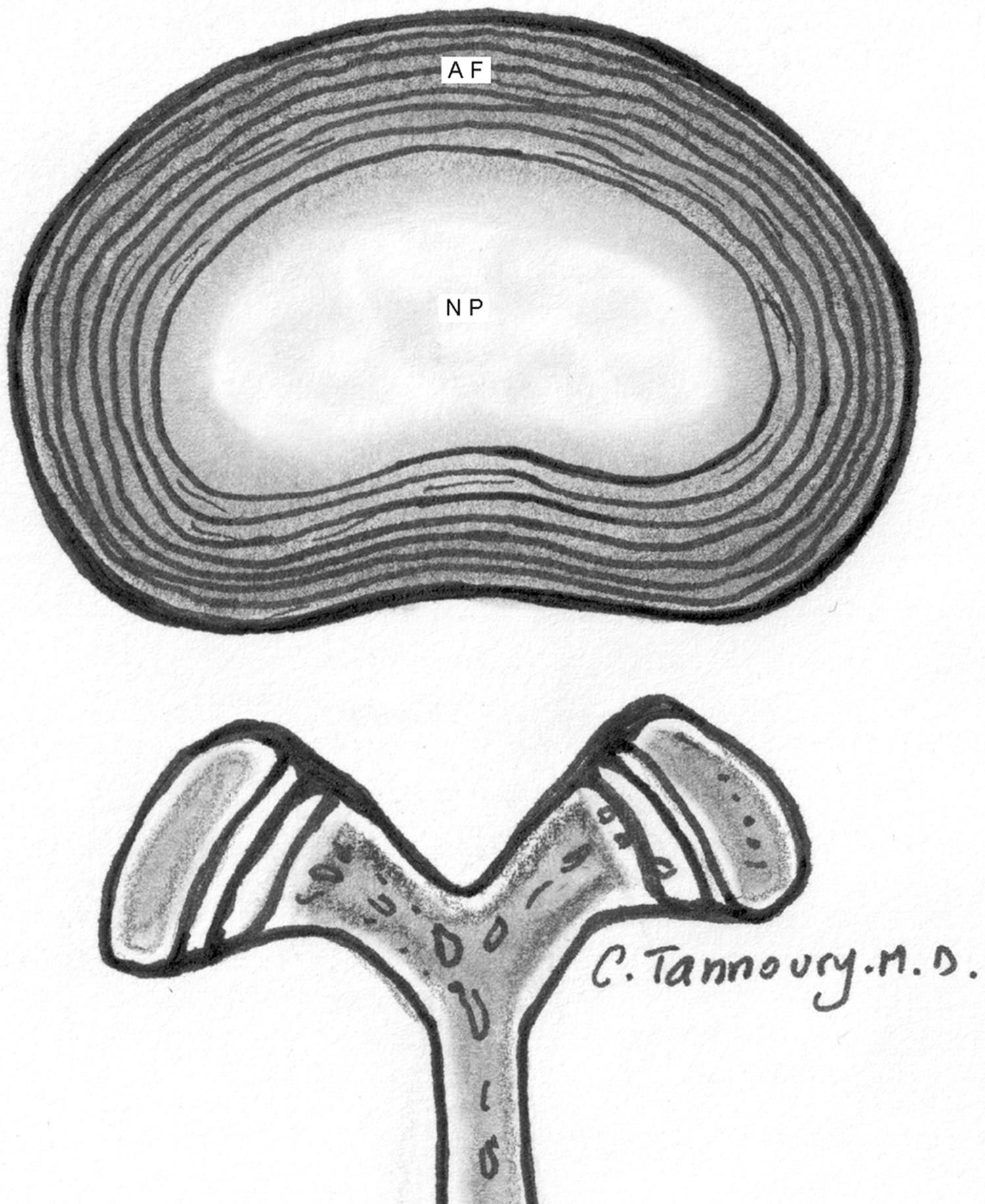
The IVD space is defined, above and below, by boney apophyseal endplates and, peripherally, by planes from the peripheral edges of the apophyseal bone of the superior and inferior vertebral bodies [ , ]. In defining the boundaries of the disc space, one should ignore osteophytes. Particular IVDs and IVD spaces are named by abbreviating the region of the spine (C cervical, T thoracic, L lumbar, and S sacral) and further specified as to level by adding the numbers of the vertebrae above and below (e.g., C3/4 defines the IVD lying between the third and fourth cervical vertebrae). Anomalies are common and require narrative descriptions for accurate communication. Anomalous “transitional” vertebrae and IVDs are most common at the lumbosacral junction and are sources of miscommunication that could be avoided by a clear explanation of the anatomy and chosen nomenclature [ , ].
Body weight and muscle tone create constant pressure within the disc space, which is magnified by stresses of posture, activity, or trauma (see Chapter 15, Chapter 2 ). Pressure on the normal IVD imparts a force to displace the nucleus beyond its boundaries [ , , ]. Nucleus displacement is resisted by the ligamentous substance of the annulus and the entheses where fibers of the annulus attach to apophyseal bone. The annulus is a laminate of multiple fibers, which, in its normal state, is very resistant to full-thickness disruption. The tensile strength of the annulus is particularly great, individual fibers being more vulnerable to torque than to distraction [ , , ]. In the posterior midline, the posterior longitudinal ligament reinforces the annulus. Similarly, the anterior longitudinal ligament provides support to the annulus anteriorly [ , ].
Within the vertebral canal, the peridural membrane suspends epidural fat and blood flow to the dura and epidural space, including Batson's plexus of veins [ ]. The peridural membrane makes loose attachments to the dura, root sleeves, and interior walls of the vertebral canal. The diaphanous nature of the peridural membrane provides no significant structural support; however, it may contain displaced IVD material and it may influence the flow of injectate or the spread of infection [ , ] ( Fig. 8.2 ).
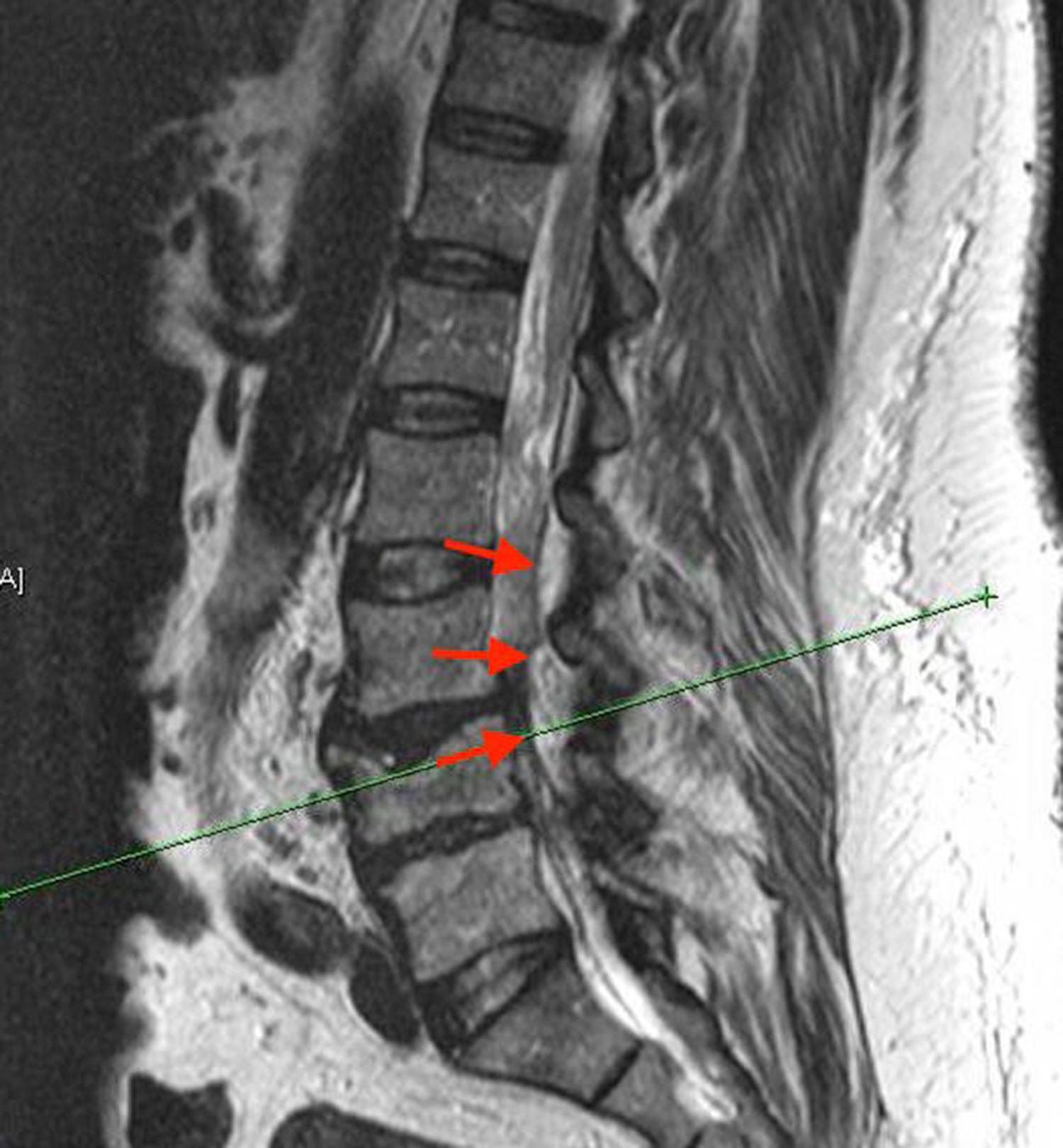
Displaced IVD material can efface and compress nerve roots within the thecal sac in the central canal, or the traversing or exiting nerve roots within dural sleeves as they course through the subarticular recesses and through the intervertebral foramina [ , ]. Within or beyond the foramen, it may contact the dorsal root ganglion.
The anatomic levels of displaced IVD material are defined by the planes of vertebral endplates and adjacent pedicles as “suprapedicular,” “discal,” or “infrapedicular.” In the axial plane, the medial edges of the facets, and the medial and lateral planes of the pedicles define zones designated as “central,” “subarticular,” “foraminal,” “extraforaminal,” and “anterior” [ , ] ( Fig. 8.3 ) (see Chapter 14 ).
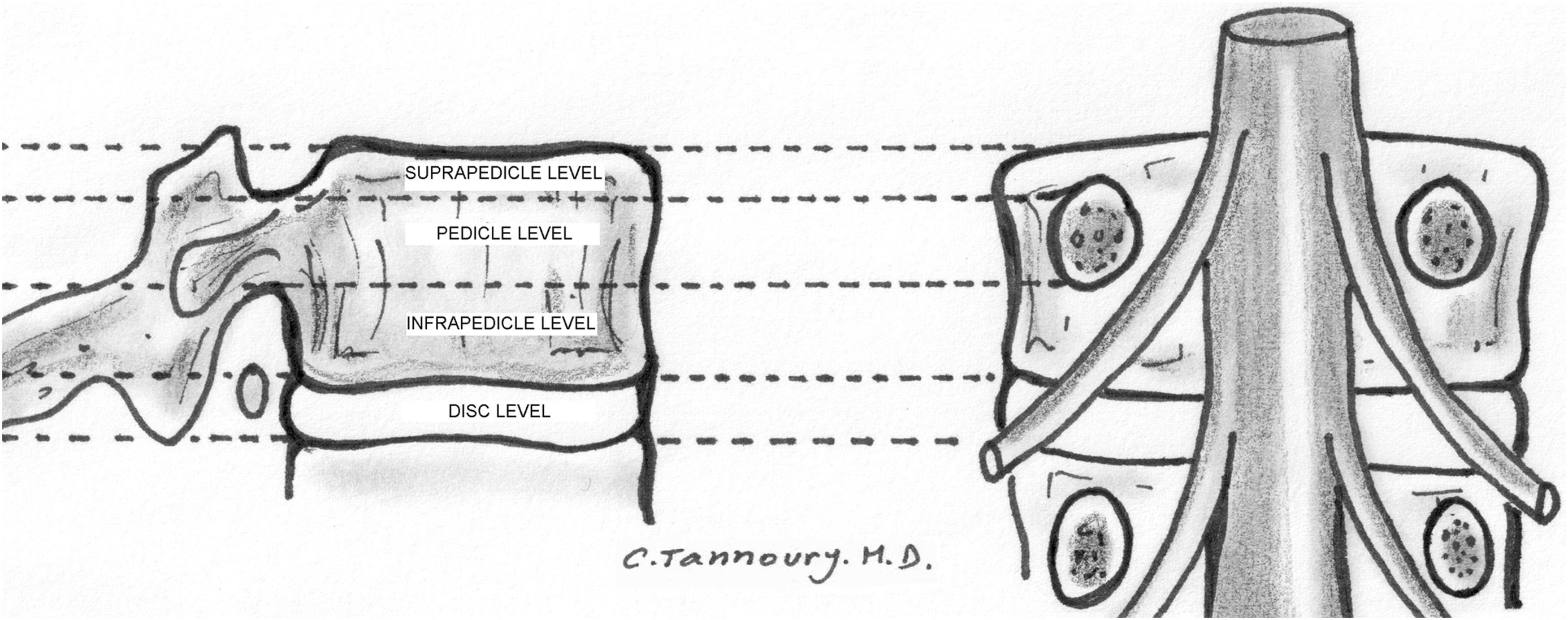
Displacement of IVD material may be painless or symptomatic in response to anatomic and physiologic effects [ ]. The annulus contains pain sensors, as do the nerve roots and surrounding dural sleeves. Inflamed posterior rami and sinuvertebral nerves are avenues of pain perception. The dorsal root ganglion is exceptionally sensitive and is usually located in or just lateral to the foramen [ , ] ( Fig. 8.4 ).
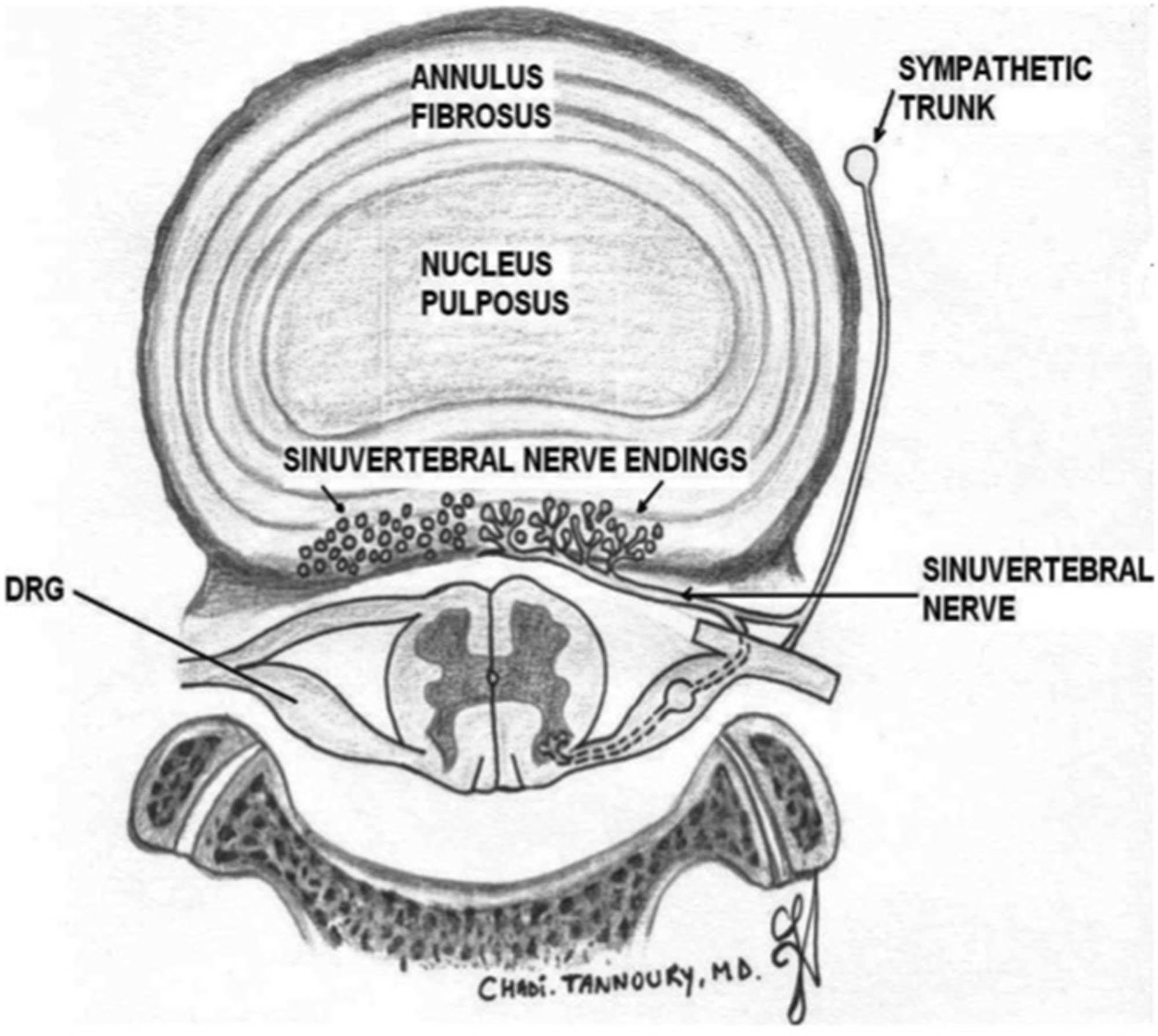
Arterial supply to the neural elements may be compromised by a mechanical compression resulting from IVD herniation, lumbar stenosis, and postural changes [ , ] (see Chapter 13 ). Unobstructed vascular and cerebrospinal fluid flow are crucial to a healthy function of the neural structures of the spine [ , ].
The normal IVD is very strong. Disruption of a normal IVD with displacement of material is not likely to occur from a physiologic stress or most supraphysiologic strains and, when it does occur, it is likely to be a result of violent injury [ , , ]. Whether lesser injury or injuries contribute at some stage of the process leading to IVD displacement is often a difficult clinical distinction to be made on an individual basis. Notwithstanding the need for individualization, IVD displacement, in general, is best considered as the result of degeneration rather than trauma, a concept that does not exclude the possibility that a traumatic event might result in displacement of a previously degenerate IVD, analogous to an automobile tire, thinned by excessive wear, blowing out after rolling over a stone.
IVD degeneration has been understood, based upon the expansion of the original studies and theories of William Kirkaldy-Willis, to follow a “cascade” of events [ ]. The initial event, desiccation of the nucleus, has been the most challenging to identify. Drying of the nucleus is so ubiquitously observed as to be considered a normal aging process. That does not explain why the process begins at a much earlier age in some individuals and in one IVD before others in any one individual [ , , , ].
The theory that genetic predisposition plays a role is controversial and has been addressed in many studies, but often does not apply in individual cases [ , , , , ]. As discussed herein, there are several phenotypes that involve IVD displacement; therefore, genetic vulnerability could be due to biochemical abnormality in the nucleus of some, anatomic structural weakness of the annulus of some, and perhaps unrelated to genetics in others.
Desiccation of the nucleus reduces its mass. The firm cushion of a plump nucleus within tautly held IVD space is diminished, allowing “play” in the annulus [ , , , ]. The annular fibers may lose integrity and separate or delaminate, creating radial, transverse, or concentric fissures in the annulus or there may be loss or attenuation of the enthesis where the annulus attaches to the apophyseal bone [ , , ] ( Fig. 8.5 ). The fissures, representing internal disruption of the IVD, are commonly identified as high intensity zones on T2-weighted magnetic resonance imaging (MRI) images (see Chapter 9 ).
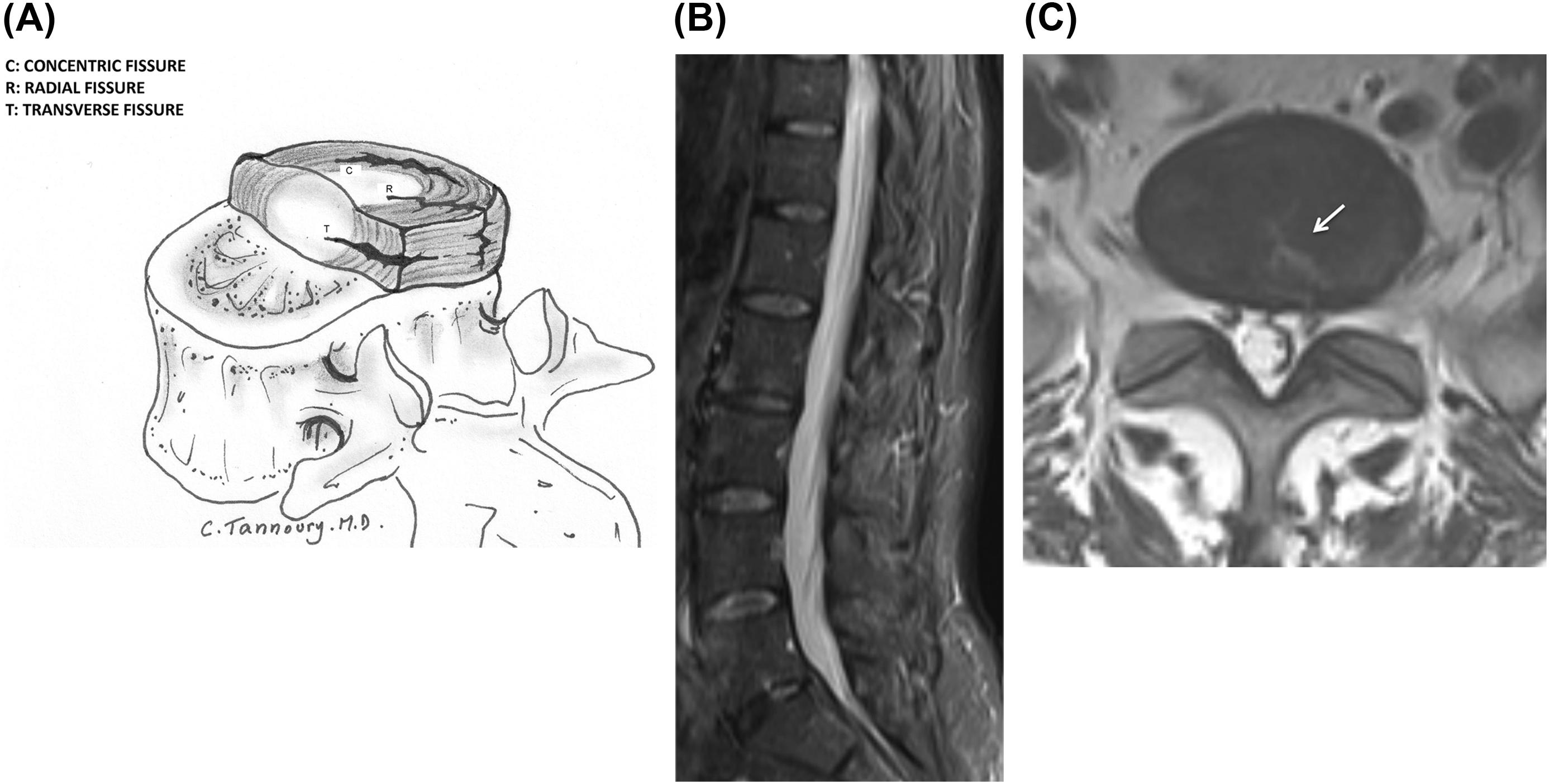
Diminished integrity of the tissues containing IVD material within the IVD space can lead to disc displacement. The site and extent of displacement depend upon the location and size of the most vulnerable site in the annulus, the location within the IVD space of the most mobile part of degenerated nuclear material, and the morphology of the degenerate fragments [ , ].
Displacement of IVD material beyond the plane of the IVD space depends upon the residual strength of intact annular fibers and, in the case of central protrusion, upon reinforcement from the posterior longitudinal ligament. Once beyond the containing annulus, the displaced IVD material, if central or paracentral, may be held by fibers of the posterior longitudinal ligament [ , ] ( Fig. 8.6 ). Beyond the annulus and posterior longitudinal ligament, displacement is limited by any residual connections between the parent nucleus and the displaced IVD material, by the thecal and neural structures and their encompassing peridural membranes, and by the bony anatomy of the vertebral canal [ , , ].
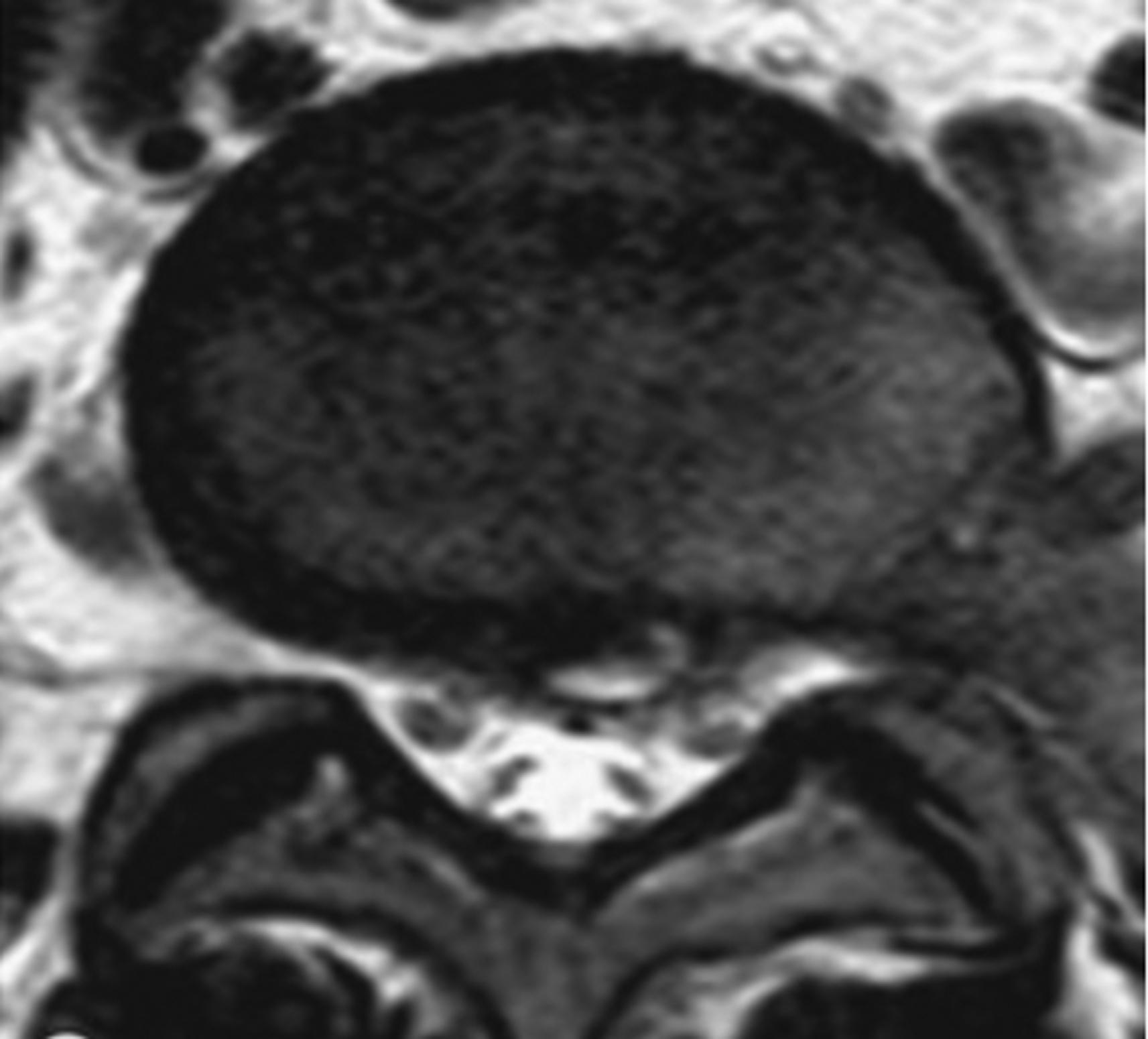
Displacement of IVD material creates more or less reactive changes in the surrounding tissues. Extruded, especially sequestrated, nucleus pulposus creates an inflammatory reaction, mediated through the peridural membrane, that can ultimately lead to absorption of the displaced material [ ].
Progression of the degenerative process may shrink the IVD space further and reduces the mass and internal pressure of contained protrusion of nuclear material. In some cases, the absorptive process leads to profound narrowing of the IVD space, once commonly called “osteochondrosis,” whereas, in others, the IVD space is relatively preserved and the process is predominantly one of hypertrophic enthesopathy, that is, “spondylosis” [ , , ] ( Fig. 8.7 ). Both conditions narrow neural pathways, increasing the chance that IVD material in those pathways will produce stenosis-related syndromes.
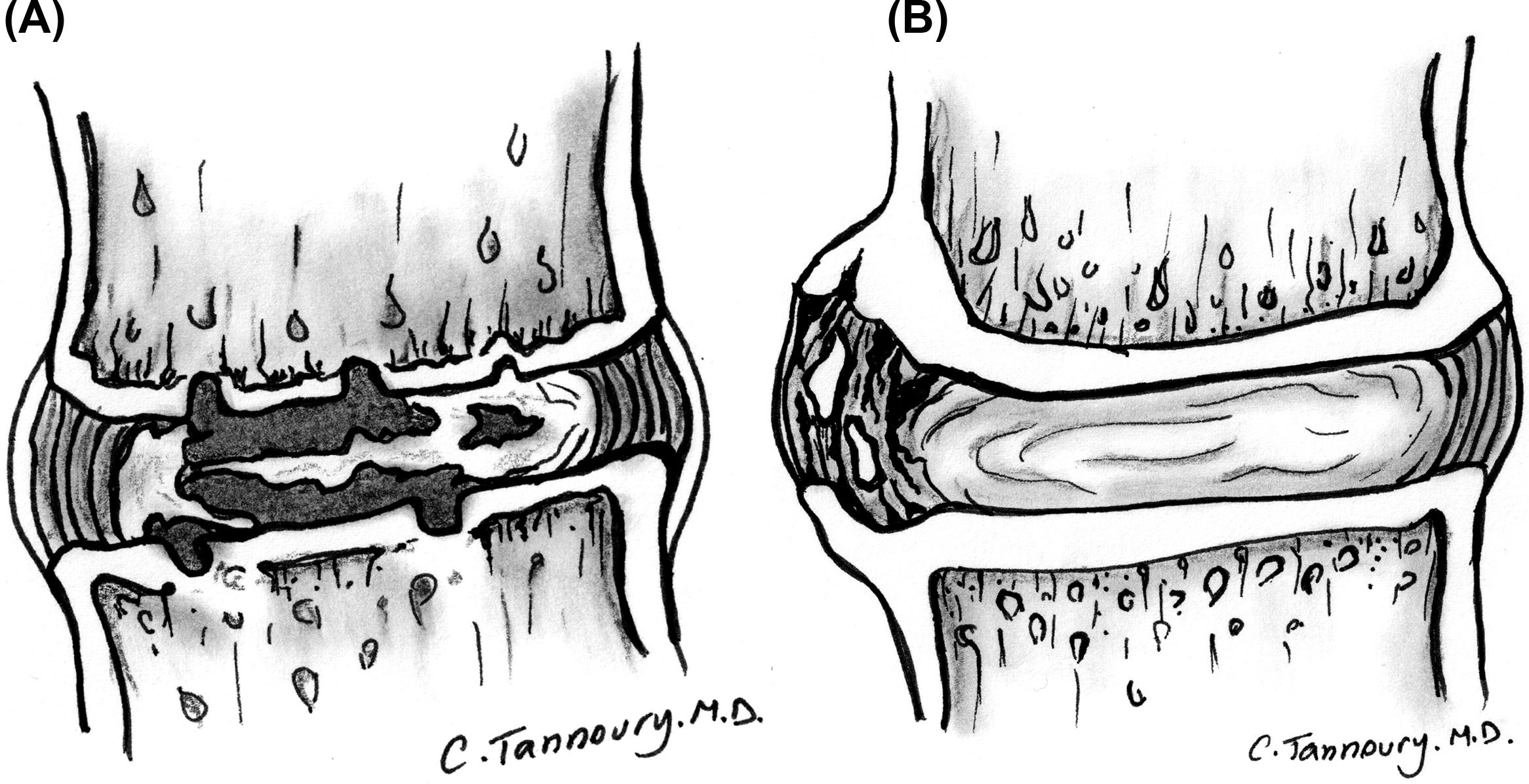
Acute displacements of predominantly nuclear tissues create distinct syndromes that are quite different from chronic effects of combinations of displaced IVD tissues and reactive change [ , , ]. To make diagnosis more challenging still, combinations of acute and chronic effects are often present concomitantly, acute changes may be superimposed upon a chronic site, or chronic sequelae may evolve from an acute event.
Clinical manifestations of IVD displacement occur from inflammation, constant or intermittent pressure on the nerve root(s), or deleterious effects from loss of the mechanical integrity of the IVD [ , , ]. Add to this that muscle sprains/strains, facet arthropathy, other common disorders and a plethora of uncommon disorders of the spine, pelvis, hips, central and peripheral nervous system, vascular disease, and systemic illnesses often manifest symptoms similar to those generated by IVD displacement, and one understands the diagnostic challenge that attracts inquisitive physicians to the specialty of spine care and makes care of patients with spinal disorders so rewarding to diagnose and treat [ ].
Except patients who cannot tolerate MRI or those who have metal near the area of concern, MRI is superior to other imaging technology for creating clinically important images of IVD displacement (see Chapter 5 ) [ , , ]. Unless extrusion of IVD material into the site of previous surgery, tumor, or infection is a consideration, administration of gadolinium is not necessary.
MRI is uniquely capable of assessing the state of hydration of the nucleus [ , ]. Degeneration diminishes the brightness of signal within the nucleus on T2-weighted sagittal images, resulting in loss of distinction between nucleus and annulus (Pfirrmann 2–5) (see Chapter 6 ) ( Fig. 8.8 ).
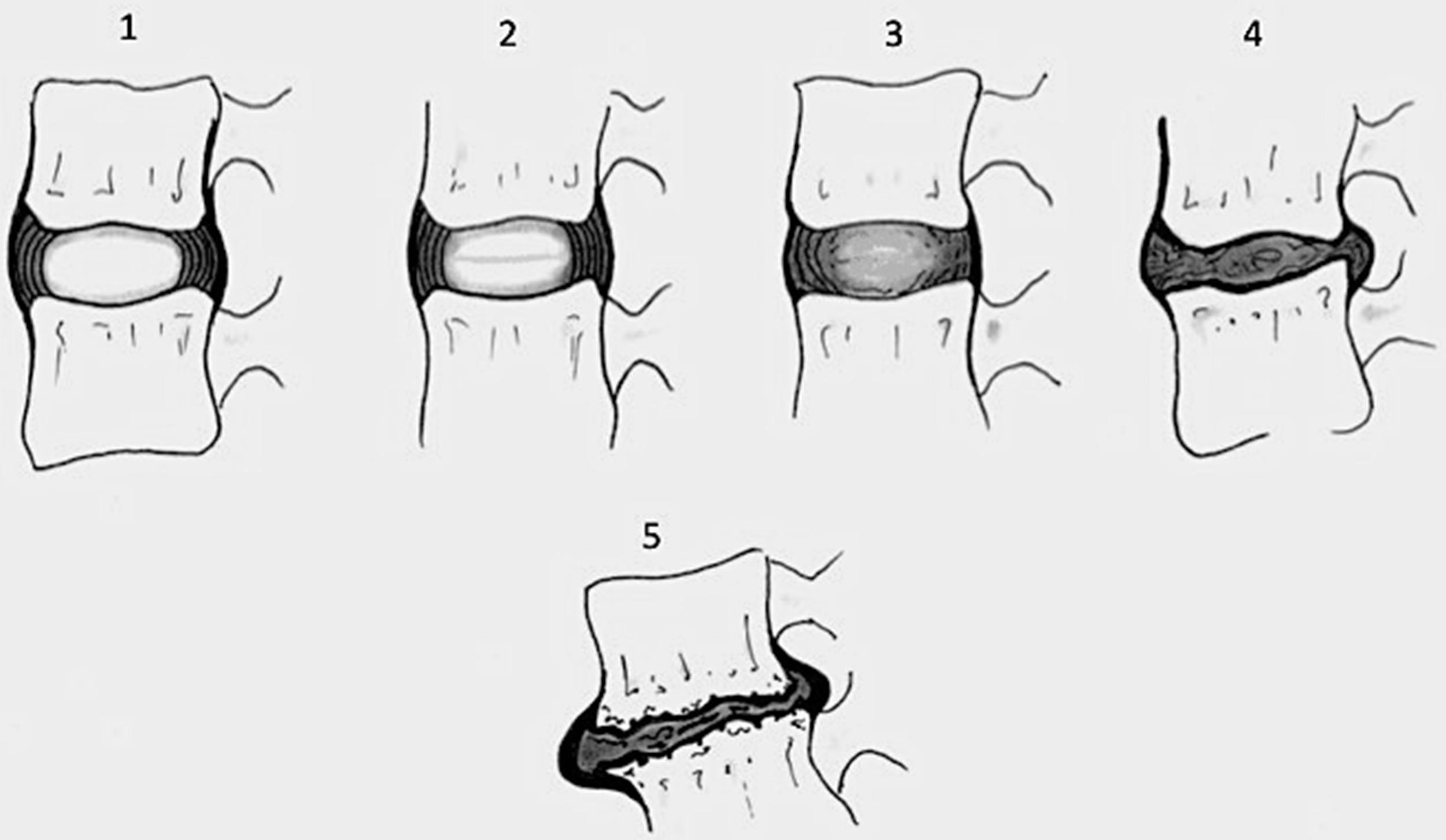
Myelography with CT scanning gives slightly less satisfying images than MRI when examining patients with commonplace IVD extrusions, but is inferior in the depiction of foraminal and extraforaminal herniations, atypical locations within the vertebral canal, and assessing compression or edema of the spinal cord [ , ]. Enhanced CT gives better images than MRI in many cases if the presence of implanted metal degrades the MRI image. High-quality CT images without contrast will define most IVD displacements though with slightly less clarity than myelo/CT or MRI.
Discography with CT provides images of fissures and fragmentation within the annulus and integrity of the annular/apophyseal enthesis [ , ] ( Fig. 8.9 ). Extrusion of intradiscally injected contrast may provide some additional imaging of IVD displacement. The value of provocative discography is controversial [ , ]. Those who have found it clinically useful have relied more upon the patients' responses to the procedure and the confirmatory images of internal disruption of the IVD than upon depiction of displacement [ , , ].
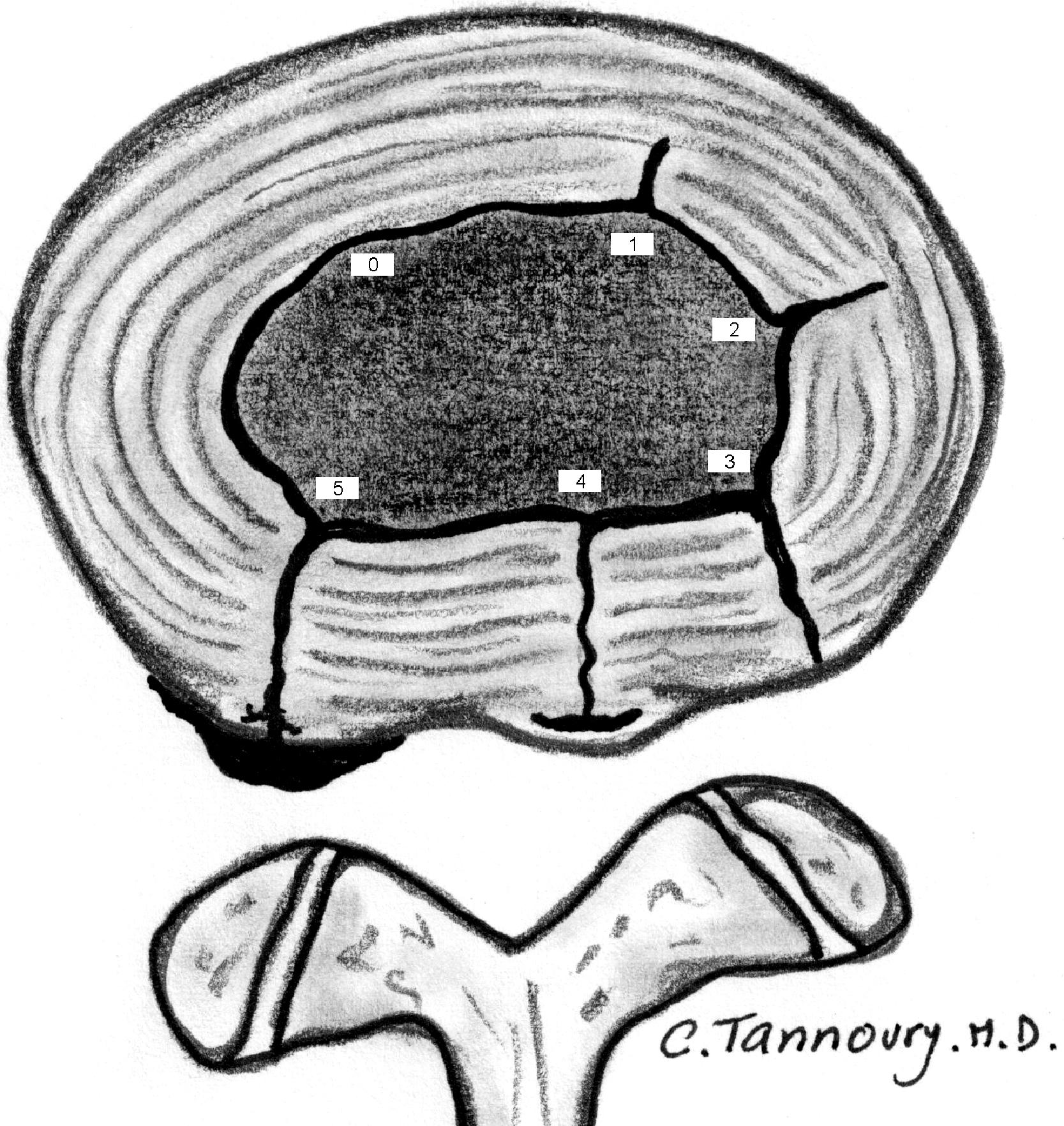
Become a Clinical Tree membership for Full access and enjoy Unlimited articles
If you are a member. Log in here